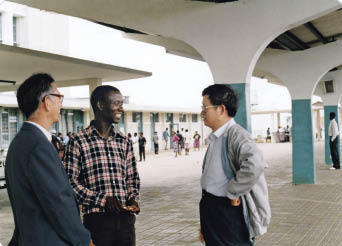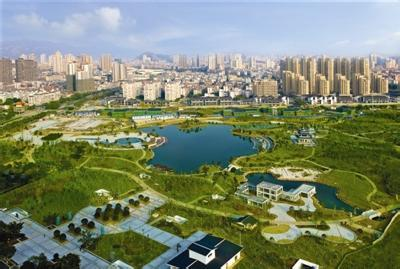Du Jian: Witness to the Birth of the TAZARA
By staff reporter LU RUCAI WHEN I graduated from college, I never thought a project like the TAZARA would ever be a phase of my career,” said retired engineer Du Jian. The TAZARA Railway, also called the Tanzam Railway, runs 1,860.5 km between Dar es Salaam in Tanzania and Kapiri Mposhi in Zambia. It was a capital-intensive aid project undertaken by China in East Africa in the 1960s and 70s, and to date remains one of the country’s largest engineering projects completed abroad. Surveying and design kicked off in May 1968, and construction started in October 1970. The rail line was completed and handed over to local authorities in July 1976. Du Jian joined the Chinese team in Tanzania in 1969 as an interpreter, thereafter becoming ever more involved in the project. From 2000 to 2006, he served as head of the Chinese experts’ panel for the TAZARA. Having witnessed the genesis and growth of the railway, including its recent management problems, Du believes that it will remain a monument to China-Africa friendship in the future. “But the host countries decide how it is to operate,” he added.
China handed over TAZARA to Tanzania and Zambia in 1976 after its completion.

Construction
Du Jian graduated from the Beijing Institute of Foreign Trade (predecessor to the University of International Business and Economics) in 1968, amid the chaos of the “cultural revolution” (1966-1976) that disrupted the country’s normal functions and operations. “Few work units were hiring.” This was the prospect he and his schoolfellows faced upon leaving campus. Normally, the Ministry of Foreign Trade would have taken in most of the institute’s alumni, but it completely shelved new recruitment that year. Most fresh graduates, therefore, had no fallback other than laboring on farms.
Luckily, Du and 47 other students were picked as candidates for English and Swahili interpreters for a railway planned between Tanzania and Zambia that China was to finance and build. These young people drove in trucks to the No. 4 Railway Engineering Bureau of the Railway Ministry in Beijing’s western suburbs, where they received “reeducation” – digging tunnels – before being dispatched to Africa in batches.
In June 1969, Du and another interpreter left for Tanzania. This was a real adventure for Chinese in those days, as few had the chance to go abroad, whether for tourism or business. Their trip to Dar es Salaam aboard Pakistan Airlines took two full days – efficient by the standards then prevailing. Most Chinese workers who built the TAZARA had first to travel to Guangzhou before taking a ship to East Africa on a journey lasting more than 20 days.
When Du arrived in Tanzania, surveying work stood at a critical juncture. Du’s first assignment was to accompany a seismographic study team from the Chinese Academy of Sciences to survey the geological conditions along the projected rail route. This experience earned him firsthand knowledge of the work and living conditions Chinese workers endured in building the TAZARA.
“It is no exaggeration to say that China exerted all its strength – in terms of manpower, materials and funds – to build this railway.” The country was hard-up in those years, but still shouldered the whole cost of its construction, including transport of 50,000 technical personnel, accommodation for Chinese engineers and workers in Africa, and employment of 50,000 to 60,000 local laborers. The official report cited a RMB 988 million no-interest loan from China to the two African countries, but according to Du, the actual cost was much higher.
“China shipped out more than 1.5 million tons of materials, including steel rail, cement and dynamite, and daily necessities, even though it suffered itself a dire shortage of all commodities. Chairman Mao Zedong and Premier Zhou Enlai nonetheless personally oversaw a nationwide mobilization to ensure that only the best-quality materials went to the project. Many factories – such as Wuhan Iron and Steel Plant – operated day and night to produce the stuff needed for the TAZARA,” Du recalled.
Over the ensuing six years of the rail line’s construction, China deployed more than 50,000 engineers and technicians to East Africa, 16,000 of them working there at one point. China dispatched five ocean liners to ply between Guangzhou and Dar es Salaam to ferry them back and forth.
Sacrifice Recognized
Although hundreds of interpreters accompanied the Chinese engineers and technicians in the two African countries, they were nevertheless insufficient by far, and communication with local workers remained a challenge. When mentoring local workers on rail technologies, the Chinese resorted to simple Chinese, a smattering of the local language, and mime.
A 150-km stretch of the TAZARA in Tanzania traverses treacherous terrain where the track has to be almost entirely elevated on bridges or routed through cuttings. The muggy local climate swelters in the summer heat. Temperatures top 40oC. Tight schedules left truck drivers with few breaks. Long periods of overwork, high stress and inclement weather engendered skin diseases in many that festered alarmingly.
Moreover, provisioning of their food supply ran far from smoothly in the project’s first years. “On bad-weather days, even providing workers with a proper meal became a problem,” Du said. Later, Chinese staff at sites where construction looked set to be particularly prolonged sought self-sufficiency by growing vegetables and raising chickens and pigs.
Of all the pangs suffered, however, the worst was homesickness. Chinese employees were granted home leave only every other year. There were few means of communication with family offered in the long intervals in-between. “Unlike today when e-mail and Wechat are very convenient, we had no access even to a telephone in those years. Work communication over long distance ensued solely via telegraph,” Du said. To expedite correspondence between Chinese workers in Africa and their families, the Foreign Ministry opened a special post service for the TAZARA project. Workers’ families directed letters to a special ministry post box. These were then sent and distributed to every construction site on the aid project in the two African countries. Each round-trip delivery cycle turned over every 28 days.
Today, Du still vividly remembers how he and his colleagues anxiously awaited the arrival of missives from their loved ones. On days planes arrived with post from China, project headquarters sent trucks to the airport where dozens of sacks of letters were offloaded. These were then brought back to the headquarters canteen for distribution to each construction site. “No matter how late the letters might reach a construction site, its staff would be waiting there. Sometimes we would dine together in celebration of the messenger’s visit,” Du said. These letters might bring good or bad news, but whichever it was, they arrived months after being posted. Letters from rural areas often missed the departure cut-off date at the Foreign Ministry, and so their transmission had to be deferred to the next 28-day cycle.
To compound their woes, malaria was also a lurking peril to Chinese staff in Africa. “It affected almost every one of us,” Du said. “Artemisinin had not yet been discovered; the only medication available was Quinine, which badly compromises the liver.” Of the 65 Chinese workers on the TAZARA who lost their lives in the line of duty, 30 percent succumbed to malaria.
During his years in Africa, Du came into extensive contact with local officials and residents who were all friendly towards him and his Chinese colleagues. “Chinese construction teams were well disciplined and hardworking, so they received unimaginable hospitality from the local community,” Du said. They were greeted by locals wherever they went, and allowed preferential treatment at customs upon entry and exit.
|
|
|
Du Jian talks with a worker at a railway station in Africa. |
Mission Completed
From the inception of its construction the TAZARA greeted African and even some Western visitors who posed the same question: “Are the Chinese really capable of building a railway on this scale?” The Chinese team replied with a preliminary affirmative after completing a section that was technically highly demanding. Foreign experts extolled their work. “Only those who built the Great Wall have the capacity to build the TAZARA,” a Swiss engineer enthused.
According to Du, the TAZARA team was exacting in its execution of technical standards. The occurrence of the slightest nonconformity mandated a complete redoing – blasting down an entire pier and rebuilding it in the case of bridge building, for instance. But this painstakingness paid off. A 1998 flood destroyed all the rail lines in one region of Tanzania with the exception of the TAZARA.
At a special session of the United Nations General Assembly in 1974, Deng Xiaoping screened for those present a China-produced documentary film, TAZARA under Construction, which caused a sensation. “The role of this railway cannot be underestimated in the development of Sino-African relations at that time,” Du said.
In July 1976, the TAZARA was completed and handed over to the two African countries. In the fiscal year from July 1, 1977 to June 30, 1978, it transported 1.27 million tons of cargo, marking the peak in its history. “This aid project by China served two goals. First was boosting the economic development of regions along the rail line and hence that of the two host countries. Second was breaking the economic blockade imposed by racists in South Africa by opening up a safe route for cargo transport in Zambia as well as supporting the countries in the southern part of the continent that had not yet won independence to achieve it. The TAZARA accomplished its mission in both senses,” Du said. By the end of 2013 the rail line had transported more than 28 million tons of goods and 46 million passengers.
Du is frank about the deteriorating performance of the railway in recent years. According to him, since its hand-over, the Chinese side has sponsored 15 sessions of technical cooperation with Tanzania and Zambia. The number of Chinese technicians stationed in Africa exceeded 1,000 at its height, and is close to 10 at present. At the time of handover, the Chinese team submitted voluminous documentation detailing the rules for the railway’s operation and personnel management, together with equipment manuals. China also provided training to numerous African technicians. Beijing Jiaotong University enrolled 100 students each from Tanzania and Zambia in a railway management program. Mobile and permanent training schools were also instituted in the two countries. On the African side, however, when local technicians retired, the number of candidates qualified to replace them proved insufficient. As equipment and infrastructure aged over time, the government of neither nation appropriated the funds requisite for upgrades. As a result, the line now sees less use than before. In the 2012-13 period, total freight stood at a mere 218,000 tons, just 17 percent of its peak volume.
“The approach of having two countries jointly managing a railway on the back of cooperation with a third nation is simply not viable,” Du concluded. “But specific issues over how to operate the TAZARA should never overshadow the railway’s status as a monument to Sino-African friendship.”


